Home » News »
A closer look at the Port Botany expansion project
« Previous | Next »
The Port Botany Expansion project is one of the most impressive infrastructure projects of Australia. Sydney Ports Corporation delivered it through Baulderstone, Jan De Nul Joint Venture.
With an estimated worth of $515M, is this project worth the investment? Does establishing five new shipping berths and reclamation of 60 hectares of land justify the amount used to complete this project?
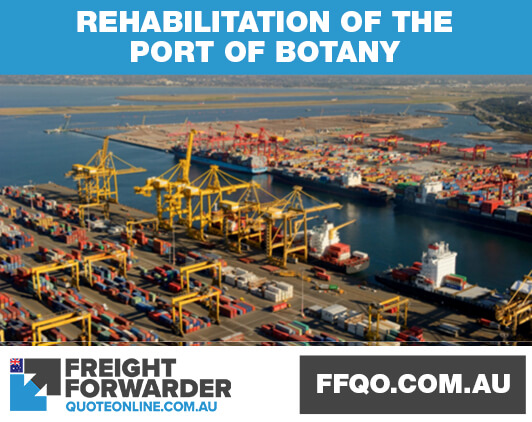 Improvements due to the Port Botany expansion project
Improvements due to the Port Botany expansion project
Let’s take a closer look at how it improved trade in the region and the impact it has for both importers and exporters.
Port Botany expansion and its relation to sea freight rates
Last 2001, World Bank made a study on transports costs. It explored the reasons why it can even be higher than tariff costs. As a result, it became a great barrier to trade.
One considerable example for this is the table below. It shows the percentage of tariff and transport rate of Australian exports to the United States.
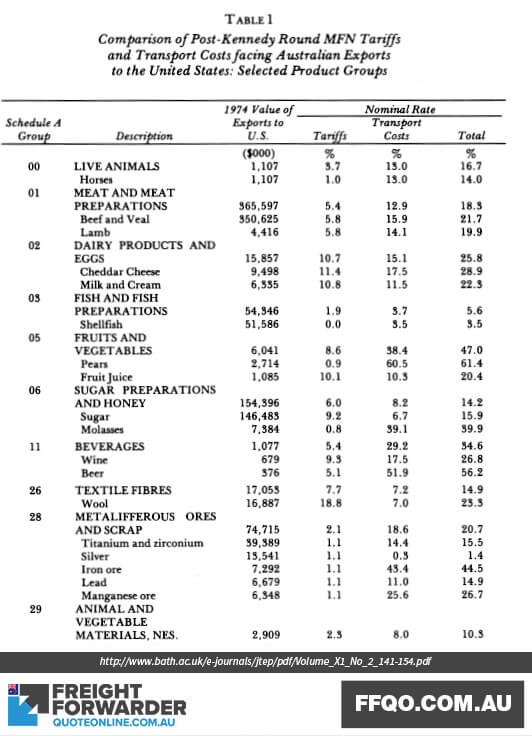 Comparison of tariff and transport cost of exported products from Australia to the US
Comparison of tariff and transport cost of exported products from Australia to the US
Here, you can clearly see that most of the transport costs are double of the tariff cost.
But, why?
The answer is simple. Poor transport services and infrastructure results in high transport cost and lengthy delivery. This is due to the following factors:
- Balance of trade
- Type of goods
- Mode of transport
- Distance
- Geographical characteristics
- Degree of containerization
- Route traffic
- Quality of transport infrastructure
- Efficiency of transport services
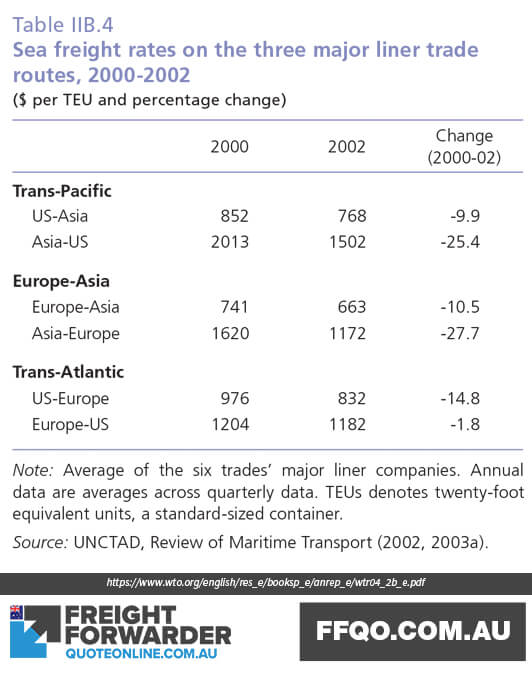 Caption: Sea freight rates on three major trade routes, 2000-2002
Caption: Sea freight rates on three major trade routes, 2000-2002
Two things can be observed from the table above. These are as follow:
- Sea transport cost decreased over the two years gap between 2000 and 2002.
- Sea freight rates are not stable.
Why are sea freight rates not stable? One apparent factor is port efficiency. Thus it is of utmost importance to improve port infrastructure.
Read how the Port Botany expansion project increased the efficiency of trade in Australia.
Improving efficiency and the Port Botany expansion project
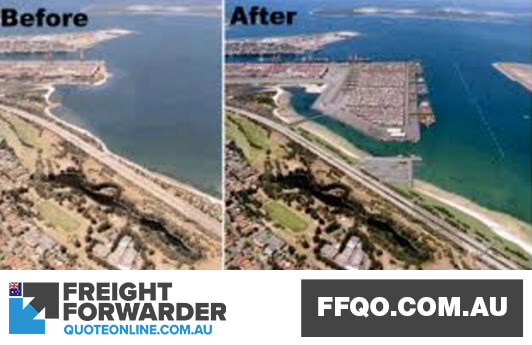 Before and after photos of Port Botany expansion project
Before and after photos of Port Botany expansion project
Early beginnings of Port Botany
In the year 1995, Sydney Ports Corporation (now part of Newcastle Port Corporation trading as Port Authority of New South Wales) managed Port Botany’s commercial shipping. However, due to the average 7.4% growth in trade; it predicted a great increase in demand in the years to come. Thus by 2010, demands exceeded the maximum capacity of the port.
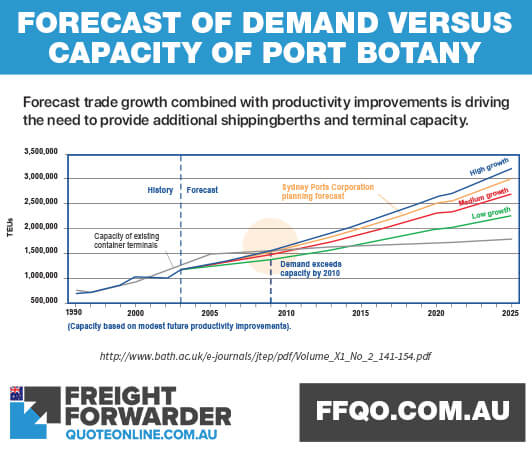 Forecast shows that by the year 2010 the demand will exceed the capacity of Port Botany
Forecast shows that by the year 2010 the demand will exceed the capacity of Port Botany
With this in mind, congestion and inefficiency were set to rise. The table below shows the data from 1971 to 2003.
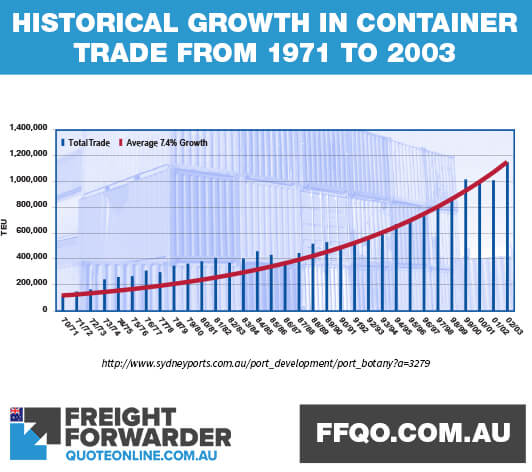 Historical growth in container trade from the year 1970 to 2003
Historical growth in container trade from the year 1970 to 2003
Due to this reason, the Sydney Ports Corporation proposed to expand the port of Botany. This is to handle the increasing number of container trades for at least 20 years.
Port of Botany expansion details and features
The Port Botany expansion grant of approval happened 13 October 2005. It is the largest port project for the past three decades for Australia.
This involves the 60 hectares land adjacent to the existing Patrick Terminal at Port Botany. Here is where the construction of Terminal 3 is to take place.
Interested to learn more about the project? Here are some of its features:
- 1,850 metres of additional wharf face for five extra shipping berths
- 60 hectares of reclaimed terminal land
- Deep water berths with depths of up to 16.5 metres
- Dredging of approximately 7.8 million cubic metres of fill material to create shipping channels and berth boxes
- Dedicated road access to the new terminal area
- Additional rail sidings to provide rail access to the new terminal area
- Rehabilitation and expansion of Penrhyn Estuary to create a secure estuarine environment
- Community facilities including boat ramp, look outs, and pathways.
As a result, the Port Botany Expansion Projects delivers more benefits to importers and exporters.
Improvement of trade resulting to the Port Botany Expansion Project
The whole expansion project is yet to conclude. However, its positive effects are already very visible. See the Annual Report brief below:
- Total full container imports increased from 1.7% to 1.02 million TEUs.
- Overall full container exports decreased from 0.8% to 0.46 million TEUs.
- Entire trade increased by 3.1% to 30.7 million mass tonnes.
- Investment grew to $151.2 million in new capital projects.
- Total non-current assets increased from 10.2%to $2.0 billion.
- Truck Turnaround Times improved by 30%. This is after just one year of operation of the Port Botany Landside Improvement Strategy.
Sydney Ports on the right track thanks to the Port Botany expansion
Since the mid 90’s, the volume of container trade coming through the port of Botany got an annual growth trade of around 7.4%. This is the report of Sydney Ports Chief Executive Officer Grant Gilfillan in an article published 23 November 2012.
Grant Gilfillan announced that due to the expansion project, the port now handles more than $60 billion trade every year. Consequently, this contributes $2.5 billion to the New South Wales economy.
It had a very strong financial year. In the 2011/2012 report, the total revenue increased by 8% to $276.5 million. Moreover, it became the pride of Australia as it won the Australian Construction Achievement Award in 2012.
How important is infrastructure upgrade to importers and exporters?
If a country’s infrastructure rises from median to the top 25%, what will happen?
Limão and Venables shared the following results.
- It cuts transport cost by an amount equal to 481 km inland and 3,989 km sea travel. Thus providing reduced costs for importers and exporters.
- It decreases distance among countries. Hence an increased trade volume of 68%.
Sadly, these are the effects of infrastructure deterioration:
- It raises transport costs by 12%.
- It reduces trade volumes by 28%.
The infographic below will make us understand the above declaration easier.
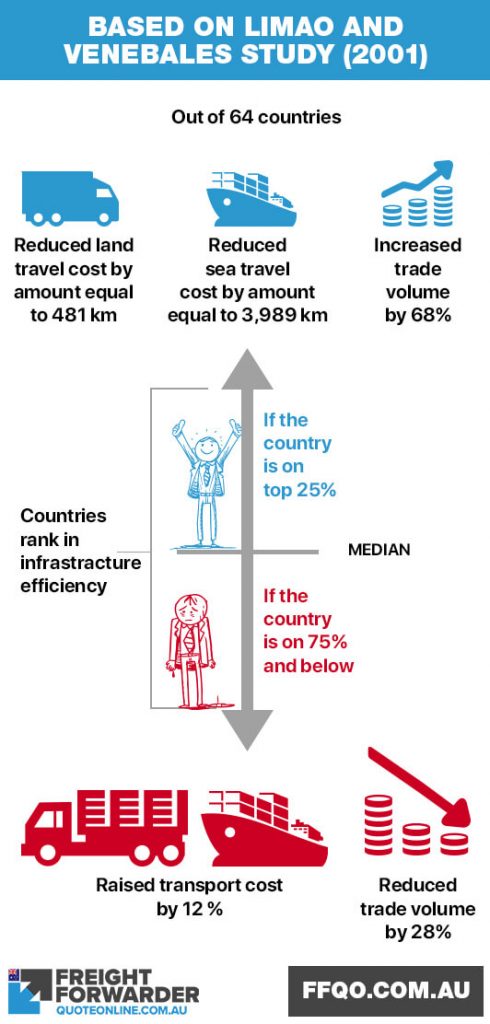 Better infrastructure resulting to better trade
Better infrastructure resulting to better trade
In conclusion, the more efficient the infrastructure is within a country, the better the trade.
Australia focuses on improving infrastructure
On a news article published July 2016, Australian Logistics Council (ALC) released a six-point plan. It aims to improve Australia’s supply chain and referred to as ‘Getting the Supply Chain right‘.
The plan is to get the following right:
Structure Right
- Create a freight policy division within Australian Government
- Establish a specialist economic regulator
Planning Right
- Prevent residential encroachment on working sites
- Make transport corridors properly preserved for future use (named Badgerys Creek)
Rail Right
- A necessity to develop inland rail hubs and short haul rail
- Establish freight rail policy and fixing regulatory duplications
Road Pricing Right
The need to develop new road pricing system. This is to replace the current PAYGO formula.
Road Safety Right
The need to Oppose the Road Safety Remuneration Tribunal (the RSRT). This includes those that may overlap with the Heavy Vehicle National Law.
Technology Right
Improve technology in the rail freight sector
As a summary, the plan focuses on improving the infrastructure of Australia. This is to ensure Infrastructure Australia has all the resources needed.
Give us feedback and contact us
Our freight network to and from Australia has approximately 40,000 locations and relies entirely on our infrastructure. Feel free to let us know what you think on this topic contact us online and send a message. You can even message us on Facebook.
If you need a quote on doing your Australian air or sea freight, consider us. We are a transparent and efficient freight forwarding service and an Australian market leader,
Check out our other recent articles
Latest news
Read up on the latest Australian freight forwarding news and developments:
Marine cargo insurance, should you buy it? - 28 May 2023
Aus UK FTA 2023 highlights in of the new free trade agreement - 07 Apr 2023
Types of cargo shipped via sea freight - 05 Mar 2023

Get social with us
Check us out on Facebook. Get social and like our page. Feel free to post your thoughts - we will appreciate it.
Come see our clips on our YouTube channel and subscribe so you are notified when we add new ones.
To keep up to date with the industry and read up on industry trends and developments, follow us on LinkedIn.
For quick updates, follow us on Twitter.
1300651233